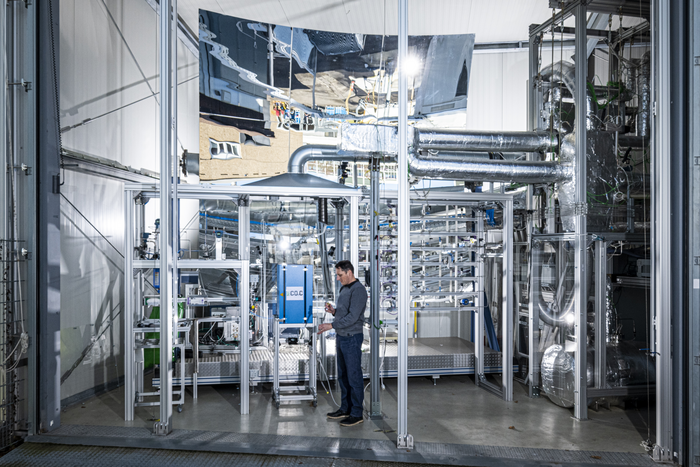New facility at KIT produces carbon out of ai
image: The new NECOC facility at KIT produces the high-tech resource carbon out of the climate-harming CO2 in the ambient air. (Photo: Markus Breig)
view more
Credit: Markus Breig, KIT
Germany is progressing on its way to climate neutrality – and has to close carbon cycles in its industries as soon as possible to get there. To reach the 1.5-degree target, the Intergovernmental Panel on Climate Change (IPCC) suggests to remove and permanently store already emitted CO2. “We have to find completely new technological solutions if we want to keep up industrial production,” says Dr. Benjamin Dietrich of the KIT Institute of Thermal Process Engineering (TVT). ”This includes the industrial carbon supply. Carbon is needed for the production of batteries, building materials, colors, and in the agricultural sector. So far, it comes largely from fossil sources.” In the research project NECOC (short for: NEgative CarbOn Dioxide to Carbon) coordinated by Dietrich, the associated partners KIT, INERATEC, and Climeworks develop a process to convert CO2 from the atmosphere into carbon. “If this carbon remains permanently bound, we successfully combine negative emission with a component of the post-fossil resource supply as part of a future carbon management strategy. This represents a double contribution to a sustainable future,” Dietrich explains. In the first project phase, the research team constructed a container-sized test facility, which now went into operation. This first-phase installation removes two kilograms of CO2 from the ambient air in one day and turns it into 0.5 kilograms of solid carbon.
In Three Steps from Greenhouse Gas to Useful Resource
The NECOC process combines three steps: The first is an absorber to separate the CO2 from the ambient air (Direct Air Capture). In the second step, the CO2 is moved to a microstructured reactor, where it reacts with sustainably produced hydrogen from a connected electrolyzer. Its components, carbon and oxygen, form new bonds and the CO2 becomes methane and water. While the water flows back to the electrolyzer, the methane including the carbon ends up in a reactor with liquid tin. This is where the third process step takes place: In rising bubbles, a pyrolysis reaction splits the methane molecules, creating hydrogen, which can be returned to split CO2. The only remaining part is carbon, which floats on the tin as micro granular that can be taken off mechanically on a regular basis. Changing process parameters like the temperature level allows the production of different carbon modifications like graphite, carbon black, or even graphene.
Optimize and scale for industrial applications
The start of the test installation is an important milestone for the NECOC project, as well as the end of the first funding phase. In a second project phase, the NECOC procedure will now be scaled up and optimized for expansion. “We are planning to make the procedure more energy-efficient by improving the energy recovery from the process heat,” states project director Dr. Leonid Stoppel from the Karlsruhe Liquid Metal Laboratory (KALLA). “We are also looking into an integration of high-temperature heat storage and direct solar heating.” Additional points of research are the inclusion of CO2 point sources, novel approaches to the extraction of CO2 from the air, and the influence of trace components and impurities in the process network on the carbon quality.
About NECOC
In the framework of the NECOC research project, a climate-friendly procedure with negative emissions is developed for the production of the high-tech resource carbon from atmospheric CO2 as an element of a carbon management strategy. NECOC started at the end of 2019 with the construction of the components for the three underlying process steps: Direct Air Capture, methanization, and pyrolysis. After the successful testing of each individual component, the combined installation was realized in 2022 and put into operation at the beginning of December. Involved in the project are the Karlsruhe Liquid Metal Laboratory (KALLA) as part of the Institute for Thermal Energy Technology and Safety (ITES), as well as the Institute of Thermal Process Engineering (TVT). Project partners are INERATEC GmbH, a KIT spinoff, and Climeworks Deutschland GmbH.
More information (in German): https://www.tvt.kit.edu/21_3547.php
More about the KIT Energy Center
Being “The Research University in the Helmholtz Association”, KIT creates and imparts knowledge for the society and the environment. It is the objective to make significant contributions to the global challenges in the fields of energy, mobility, and information. For this, about 9,800 employees cooperate in a broad range of disciplines in natural sciences, engineering sciences, economics, and the humanities and social sciences. KIT prepares its 22,300 students for responsible tasks in society, industry, and science by offering research-based study programs. Innovation efforts at KIT build a bridge between important scientific findings and their application for the benefit of society, economic prosperity, and the preservation of our natural basis of life. KIT is one of the German universities of excellence.
Disclaimer: AAAS and EurekAlert! are not responsible for the accuracy of news releases posted to EurekAlert! by contributing institutions or for the use of any information through the EurekAlert system.



Comments are closed.